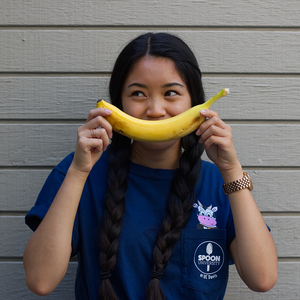About one third of all food in the United States gets thrown away. One way to reduce our waste is to compost our food scraps. You may have seen those big compost bins in someone’s backyard, but did you know you can compost in a space as small as a dorm room?
This is why vermicomposting is so easy and convenient. All you need is a small bin or bucket, some newspaper or leaves, your food scraps, and some worms. Yes, I know it sounds gross, but vermicomposting produces no mess or smell. And worms are the perfect stress-free, low-maintenance pets.
After a few months you’ll be able to use your compost as a nutrient-rich and chemical-free fertilizer for your plants. Even if you don’t have any plants at home, composting helps divert your food waste from landfills back to the earth.
What is Vermicomposting?
Vermicomposting uses worms to turn organic waste into a rich fertilizer that provides many of the nutrients plants need. Basically, you’re harvesting worm poop.
Unlike chemical fertilizers, vermicompost doesn’t contain acids that degrade the soil over time. Chemical fertilizers have also been known to produce fruits and vegetables with less flavor and nutritional content. So if you grow your own food at home, vermicompost is the way to go.
Worms

You’ll need one half to one pound of worms, depending on the size of your bin. Any type of worm will get the job done, but red worms and red wrigglers are your best bet. Other common earthworms, like nightcrawlers, are deep diggers, so they don’t do so well in confined spaces. Red worms and red wrigglers, on the other hand, are surface feeders.
The best place to get your worms is a local garden center or nursery. Worms sold as bait will work, but sometimes these worms are already dead, so obviously they’re not going to eat your food scraps. So please make sure you buy live worms.
Did you know? A red worm can eat over half its body weight everyday!
Bins
Choose a bin based on how much food you’ll be composting. A bucket works well if you want something compact, but a wide storage bin will have more surface area. More surface area means you can add more food!
Make sure to drill holes at the top of the bin for ventilation. You can even drill drainage holes at the bottom and then place it in another bin. The liquid that collects at the bottom is called leachate and can be diluted with water to make compost tea, a nutrient-rich drink for plants. This stuff helps them grow and protects against fungus and disease.
Bedding

Having a light and fluffy bedding allows worms to live comfortably and helps to absorb excess moisture. You can use newspaper strips, straw, or leaves. Avoid the glossy paper that sometimes come with newspapers, since this has chemicals that will leach into your compost.
#SpoonTip: If you’re using newspaper, make sure the ink is soy-based!
Make sure to have about six inches of moist bedding at the bottom of your bin, along with a thick layer of dry bedding on top to insulate your worms. The bedding should be light enough so that air can flow through. Otherwise, worms can suffocate and die. Don’t be a worm murderer.
Location
Worms are best kept indoors away from direct sunlight. You can stow them away under the kitchen sink, in the pantry, or even under your bed (don’t tell your roommate).
If you do choose to keep your worm bin outside, be extra careful to make sure it’s in the shade, protected from rain, and insulated during the winter.
Food
Feed your worms mainly fruits, veggies, and grains. Avoid adding too many acidic things like citrus and coffee grounds. Do not feed your worms meat, dairy, or salty/fatty foods. Toss in something gritty like eggshells or nut shells to help them digest their food.
Avoid overfeeding your worms because the rotting food can make your bin smelly. Start out small, then start feeding them more if you find that all the food is gone every time you check the bin. It helps to chop up the food into small pieces (no bigger than your thumb) so that it can be eaten faster.
Harvesting

After a few months, you can begin to harvest the worm poop, or castings. You can just stick your hand in there, grab the compost towards the bottom of the bin, and pick out the worms. Or, if you have a wide enough bin, you can start feeding your worms on one side so that you can easily remove the castings.
Using Your Compost
Once you’ve harvested the worm castings, you can sprinkle them onto your plants, indoors and outdoors! Your plants will thank you for the wonderful compost you’ve blessed them with. Plus, you’ll feel so proud that you turned your waste into something useful. Yay for saving the earth!
Not down to keep worms as pets? Look for a compost drop off in your area.

This video was made in part by Campus Center for the Environment (CCE) at UC Davis. As a student-run organization, CCE works to increase the visibility, capacity and effectiveness of individuals and groups engaged in activities to improve environmental education, awareness, ecological health and environmental justice on the UC Davis campus. It also offers free composting workshops, makes presentations to clubs and classrooms and pick ups food scraps from several locations on campus, which are then composted in our windrow compost pile. If you have any questions on composting, their unit or sustainable living email them at cce@asucd.ucdavis.edu. You can also like them on Facebook and check out their website for updates.


